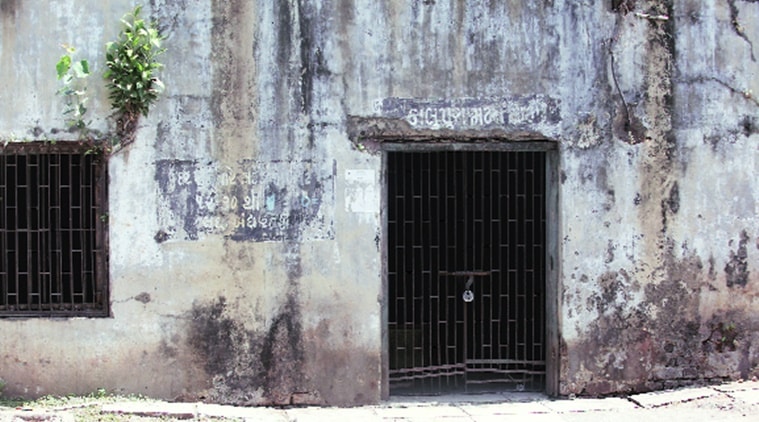 A closed mutton market in Vadodara. (Photo by Bhupendra Rana)
A closed mutton market in Vadodara. (Photo by Bhupendra Rana)
Just about a month after rates of chicken dropped to as low as Rs 40 a kilo, the prices of mutton and chicken have gone up to Rs 750 and Rs 250 per kilo respectively, ahead of Ramzan on Monday. The low supply of meat and poultry that triggered the price rise would mean that meat would be beyond the reach of many Muslim families for the festival.
Meat vendors and livestock traders say that transportation of goats from Rajasthan and MP has been held up while poultry farms have lowered their production following heavy losses during the beginning of the lockdown in April. With livestock mandis in Ranip in Ahmedabad — the biggest in the state — as well as in Surat and the tribal weekly markets closed on account of the pandemic, the supply chain has been broken.
Frozen cuts in stores that have opened since the relaxation of the lockdown are priced even higher at as much as Rs 400 a kilo for chicken and around Rs 1,000 for mutton.
Ishrar Pathan, 45, a painter who has been out of work for over two months, says, “I exhausted all my savings to sustain the family during the lockdown. Even now I don’t have work because no one wants painters at home at such a time. Every Eid, we would buy chicken or mutton at least for a meal but this year, we will not be able to afford meat at all. But we have got Ramzan grocery from charity organisation. We will buy some eggs if my son gets some money.” His son, who works at a furniture shop, rejoined work three days ago and the family of seven has been hugely dependant on food kits being distributed by Good Samaritans.
Like Pathan, many other middle income families too feel that mutton, at least, will be unaffordable. “At Rs 750-800 per kilo, it is not something we can afford. We are a family of six and we would need at least two kilo mutton to enjoy a good Eid meal,” says Sabeena Shaikh of Vadodara.
In Ahmedabad, a Muslim trust, Isa Foundation, has decided to make meat available to the community for Rs 450 per kilo. A message widely circulated says that the families wishing to book their meat must place an advance order for Rs 100 through a mobile wallet number shared. “Each buyer can purchase mutton from 500 grams to 10 kilos,” it says. The list also includes numbers of contact persons from various minority dominated areas of the city, including some containment zones.
A seller listed on the pamphlet says, “We have taken this initiative as the meat has become unaffordable for many families. This Eid is anyway about being at home and having a meal with your family. We will sell it locally in the areas listed.”
The price rise, traders say, is due to the increased demand in the past few weeks. Kamil Raza Shaikh, whose family runs the famous Alka Mutton shop in Alkapuri, says, “The lockdown and the ongoing pandemic has meant a huge loss to our business since March… the steep prices are due to short supply as the livestock from Rajasthan has not been transported and the mandis are closed,” says Shaikh.
Most vendors say that while most people who would have purchased mutton for Eid would stay away and opt for poultry, which has also seen a steep rise in prices, a month after vendors were forced to sell surplus chicken at Rs 100 for four birds. Hanif Qureshi of the Baroda Qureshi Jamat that mainly deals in poultry, says, “When the lockdown began, the MHA guidelines clearly mentioned meat and poultry as part of essential items, sale of which was allowed. But due to restrictions from the local administration, poultry meat shops were closed. This caused heavy losses to the poultry farm owners who have now reduced production to almost half and raised the price to make up for the losses.”
The prices, traders say, increase by about Rs 100 as one goes southwards from Rajasthan. “The price usually is about Rs 480 per kilo of mutton and about Rs 130-150 of a kilo of chicken in Gujarat. As you go further to Maharashtra and Mumbai, it would be about Rs 900 per kilo. But with livestock not available from Rajasthan, which is the bulk supplier, traders are going to individual animal rearers in villages to sustain themselves. A trader who would butcher about 10 goats in a day is currently doing only 4-5 due to short supply,” Qureshi says.
With exports suspended and transportation an issue, most districts of Rajasthan and MP that rear livestock are facing financial crisis. Adil Noor, Secretary of the Livestock Exporters’ Association, says, “The rearing of livestock for slaughter is similar to farming of any crop. There is a cycle and the animals and must reach slaughter house at the end of the efforts taken to raise it. The prices will go down only when the stock is back in proportion to the demand.”